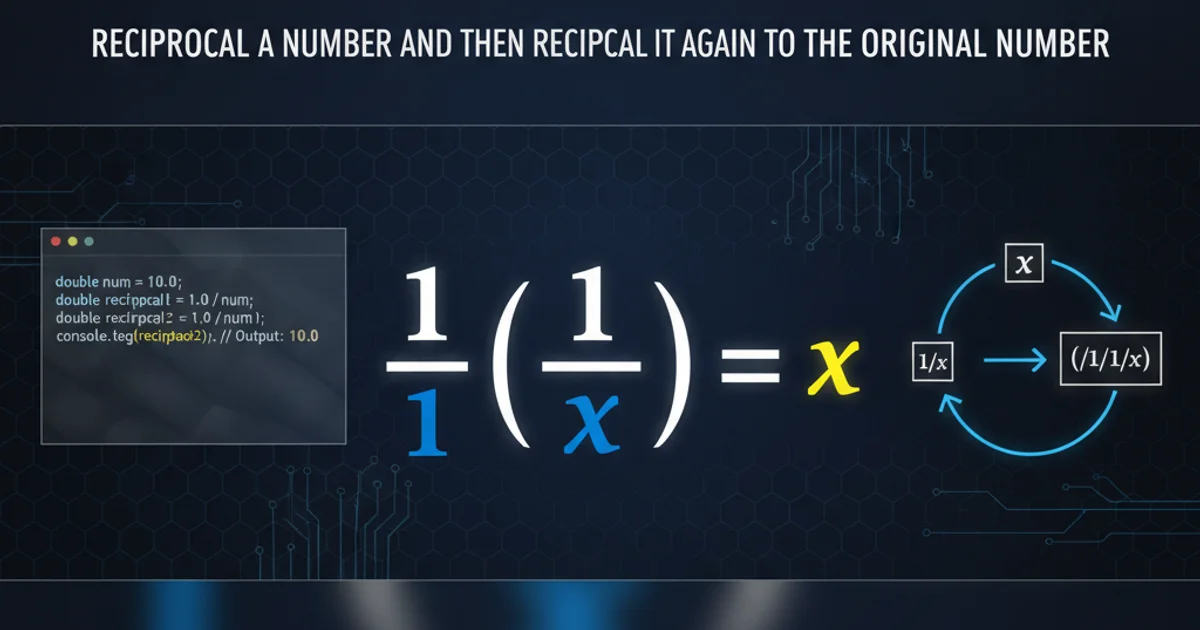Reciprocal a number and then reciprocal it again to the original number
Categories:
Understanding Reciprocals: Why 1/(1/x) = x

Explore the mathematical concept of reciprocals and demonstrate why taking the reciprocal of a number twice always returns the original number, with practical C# examples.
The reciprocal of a number is a fundamental concept in mathematics, often encountered in algebra, calculus, and various scientific fields. Simply put, the reciprocal of a number x is 1/x. A common and intuitive property of reciprocals is that if you take the reciprocal of a number, and then take the reciprocal of the result, you will always arrive back at your original number. This article delves into the mathematical proof and provides C# code examples to illustrate this principle.
The Mathematical Principle of Reciprocals
A reciprocal, also known as a multiplicative inverse, is a number that, when multiplied by the original number, yields 1. For any non-zero number x, its reciprocal is 1/x. The key condition here is that x cannot be zero, as division by zero is undefined. The property we are exploring can be expressed as the identity: 1 / (1 / x) = x.
flowchart TD
A[Start with a number 'x'] --> B{Is 'x' equal to 0?}
B -- Yes --> C[Error: Cannot take reciprocal of 0]
B -- No --> D[Calculate first reciprocal: 1/x]
D --> E[Calculate second reciprocal: 1/(1/x)]
E --> F{Is 1/(1/x) equal to 'x'?}
F -- Yes --> G[Result: Original number 'x' is returned]
F -- No --> H[Error: Mathematical inconsistency]
G --> I[End]
C --> IFlowchart illustrating the process of taking a reciprocal twice.
Proof of 1 / (1 / x) = x
Let's consider a non-zero number x.
- First Reciprocal: The reciprocal of
xis1/x. - Second Reciprocal: Now, we want to find the reciprocal of
(1/x). According to the definition, the reciprocal of any numberyis1/y. In our case,y = 1/x. - Substitution: So, the reciprocal of
(1/x)is1 / (1/x). - Simplification: When you divide 1 by a fraction, it's equivalent to multiplying 1 by the reciprocal of that fraction. The reciprocal of
(1/x)isx/1, which simplifies tox.
Therefore, 1 / (1 / x) = 1 * (x / 1) = x. This proves that taking the reciprocal twice returns the original number.
Implementing Reciprocal Calculations in C#
In C#, calculating the reciprocal is straightforward using floating-point division. We can create a simple function to demonstrate this property.
using System;
public class ReciprocalCalculator
{
public static double CalculateReciprocal(double number)
{
if (number == 0)
{
throw new ArgumentException("Cannot calculate reciprocal of zero.");
}
return 1.0 / number;
}
public static void Main(string[] args)
{
double originalNumber = 5.0;
Console.WriteLine($"Original Number: {originalNumber}");
try
{
double firstReciprocal = CalculateReciprocal(originalNumber);
Console.WriteLine($"First Reciprocal (1/{originalNumber}): {firstReciprocal}");
double secondReciprocal = CalculateReciprocal(firstReciprocal);
Console.WriteLine($"Second Reciprocal (1/(1/{originalNumber})): {secondReciprocal}");
Console.WriteLine($"\nDoes 1/(1/x) == x? {Math.Abs(originalNumber - secondReciprocal) < 0.0000001}");
// Using Math.Abs for floating-point comparison due to potential precision issues
// Test with a negative number
double negativeNumber = -0.25;
Console.WriteLine($"\nOriginal Negative Number: {negativeNumber}");
double negFirstReciprocal = CalculateReciprocal(negativeNumber);
Console.WriteLine($"First Reciprocal (1/{negativeNumber}): {negFirstReciprocal}");
double negSecondReciprocal = CalculateReciprocal(negFirstReciprocal);
Console.WriteLine($"Second Reciprocal (1/(1/{negativeNumber})): {negSecondReciprocal}");
Console.WriteLine($"Does 1/(1/x) == x? {Math.Abs(negativeNumber - negSecondReciprocal) < 0.0000001}");
// Test with zero (will throw exception)
// double zeroNumber = 0.0;
// Console.WriteLine($"\nOriginal Zero Number: {zeroNumber}");
// double zeroFirstReciprocal = CalculateReciprocal(zeroNumber);
}
catch (ArgumentException ex)
{
Console.WriteLine($"Error: {ex.Message}");
}
}
}
C# code demonstrating the reciprocal calculation and verification.
double or float) for equality, it's generally best practice to check if their absolute difference is less than a very small epsilon value (e.g., 0.0000001) rather than using a direct == comparison, due to potential precision issues inherent in floating-point arithmetic.